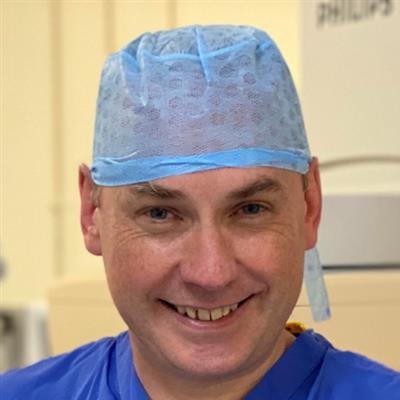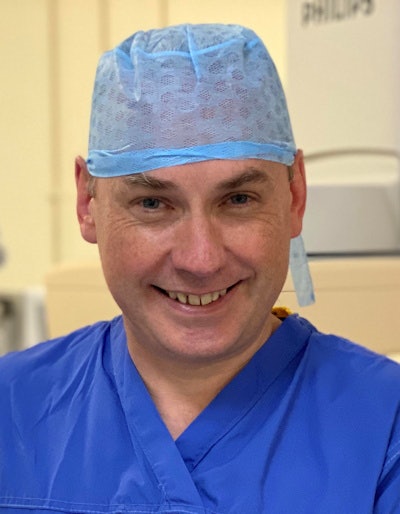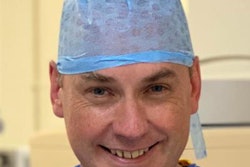
"Don't just do something, stand there." This famous quote has been attributed to Dwight D. Eisenhower, the White Rabbit, Clint Eastwood, even Elvis Presley, but it has particular relevance in medicine. Occasionally inaction is preferable.
Take the case of a man in his early 80s who is diagnosed with a large hepatocellular carcinoma. This was detected incidentally on an abdominal ultrasound examination performed after an episode of renal colic. The liver lesion is completely asymptomatic. The ultrasound scan prompted an MRI of the liver, then a staging CT, a visit to the liver surgeon, and ultimately a plan for hemihepatectomy. Because there will not be enough residual liver after this operation, he is referred to me for portal vein embolization to get the future remnant liver to grow before resection.
Modern medicine is remarkably safe. Portal vein embolization carries negligible risk. Major liver resection in octogenarians is associated with a perioperative mortality of about 5%.
 Dr. Chris Hammond from Leeds, U.K.
Dr. Chris Hammond from Leeds, U.K.There have been dramatic improvements in the safety of many invasive procedures facilitated by improvements in anesthetic care, pre- and postoperative medical management and rehabilitation, nutrition, and the advent of minimally invasive surgery and image-guided techniques. This is unarguable progress.
However, when procedures are so safe that there is very little downside to undertaking them, we create a set of ethical and evidential questions that we are poorly equipped to answer. These relate to long-term outcomes -- and predicting these on a patient-by-patient basis -- and the appropriate use of resources. As questions about "can we do this?" become easier, questions about "should we do this?" become more complex. These dilemmas are not unique to surgery and intervention: Decisions about starting renal replacement therapy are similar.
Facing a dilemma
Differing perspectives and different information is needed to answer questions about "can we?" and "should we?".
"Can?" questions tend to be technical. Is the procedure possible? How might we do it? What are the immediate periprocedural risks? Outcomes of interest are usually focused on procedure, process, operator, or institution. They are easy to measure and so are supported by a large literature of mainly cohort- and registry-based data. We know whether we can or cannot.
"Should" questions are more nebulous, patient-centered, and frequently more philosophical. Why are we doing this intervention? What are we trying to achieve? What outcomes are relevant and for whom? What do patients think? What does this patient think? What happens if we do nothing? And more widely, is it worth the cost and on whose terms?
Producing evidence to answer these questions is much more difficult. It requires engagement with patients, long-term follow-up, and an assessment of natural history of both patient and pathology with and without the intervention. This is time-consuming, expensive, and sometimes ethically difficult where professional norms have progressed beyond the evidence base. Research methodology advances such as the IDEAL collaboration (and perhaps routine dataset linkages) are mitigating some of these implementation barriers, but adoption is slow.
Furthermore, even if we have long-term meaningful outcome data for a cohort of patients, how does this relate to our patient? Risk prediction models and decision tools are frequently inaccurate or so cumbersome as to be clinically useless -- or both!
The relative absence of "should" information makes informed consent with a patient about whether to proceed very difficult. Inevitably fundamental personal, professional, and philosophical inclinations will color evidence interpretation and consent conversations. It's easy to influence a patient toward a preferred decision, especially if they are minded to leave the ultimate decision to the doctor.
Clinicians vary in their willingness to intervene: Some are more conservative than others, and it's a well-trodden path that youthful exuberance is tempered as a clinician gets older. We should be honest -- with the patient and with ourselves -- about the extent to which our personal philosophy and practice style impacts shared decision-making.
In-built need to do procedures
It's not just personal philosophy that influences decisions in the common situation where the evidence base is limited. Setting aside the distorting influence of medical device marketing -- conservative management rarely generates revenue -- there are structural features within healthcare that promote intervention over doing nothing.
First, specialties like interventional radiology exist (unfortunately still) almost entirely in the context of doing procedures, rather than managing patient pathways. Therefore, not doing something can be seen as an existential threat. What value is added if not by doing interventions?
Second, with the best intentions, we benchmark some outcomes as failure, creating pressure to avoid them at all costs. But heroic interventions to prevent these eventualities is not always good healthcare. Major amputation in peripheral vascular disease is not always inappropriate. Dying with, or even of, a malignancy does not always represent a bad outcome.
Third, there is a psychological tendency, when faced with an individual at risk, to see doing something as a moral obligation and always better than doing nothing even when the benefit is uncertain. When the risk of intervening ("can we do this?") is very low, what is there to lose? The obligation is exacerbated by public perception of modern healthcare as almost omnipotent. This "rule of rescue" is a powerful motivator for healthcare staff who are expected to treat and for patients who expect to be treated.
Finally, follow-up is often delegated away from the operator. Without the immediate and personal experience of our patients' outcomes longer term, it's easy to equate safety with efficacy, but this is a reductionist fallacy. A person's outcome depends on more than the successful management of a single pathological entity. The literature is replete with examples of successfully performed interventions that make no difference to outcome. And there is ample evidence that clinicians often overstate the benefits and understate the risks of the interventions they offer.
These structural features nudge modern healthcare toward ever increasing intervention. But in the rush to intervene, we lose sight of the option of doing nothing and thereby risk becoming more technical, less humane, and ultimately less effective as healthcare providers. Sometimes -- or perhaps often -- a sensitive conversation and display of compassion, empathy, and reassurance are preferable to virtuoso technique.
The Fat Man's 13th Rule is as relevant now as it was 40 years ago: The delivery of good medical care is to do as much nothing as possible.
My general position has slowly become increasingly conservative, and in the case of the man in his early 80s, I declined to do the portal vein embolization after a long discussion with the patient. The referring surgeon (someone I respect greatly) and I had a "frank exchange of views." Fourteen months later the patient remained well and his lesion was no larger. Clearly, this single anecdote cannot be used to justify an overall philosophy: He might have died of the lesion. He may still. I don't think that is necessarily a failure.




















